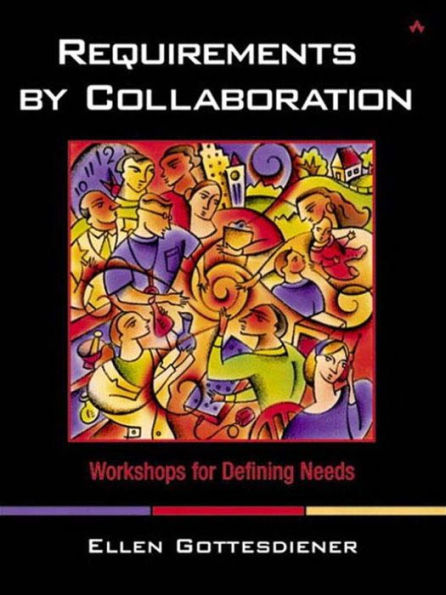Table of Contents
List of Figures. List of Tables. Preface.
The Organization of This Book.
Acknowledgments.
I. OVERVIEW OF REQUIREMENTS WORKSHOPS.
1. Getting Started with Requirements Workshops.
Essential Requirements.
Difficulties with Requirements.
Requirements Levels.
Surfacing User Requirements.
User Requirements Models.
Requirements Workshops.
Workshops and Collaboration.
Workshops and Facilitation.
How Workshops Differ from Typical Meetings.
Workshop Products.
Types of Requirements Workshops.
Other Uses for Workshops.
Workshops and Iterative Development.
Making the Business Case for a Requirements Workshop.
When Not to Use Requirements Workshops.
Summing Up.
For More Information.
2. Workshop Deliverables: Mining Coal, Extracting Diamonds.
The Evolution of Requirements.
Business Requirements.
User Requirements.
Software Requirements.
Model Views, Focuses, and Levels of Detail.
Model Views.
Model Focus.
Level of Detail.
Building the Models.
As-Is Models.
Multiple Models.
Model Briefings.
Actor Map.
Actor Table.
Business Policies.
Business Rules.
Context Diagram.
Decision Table or Decision Tree.
Domain Model.
Event Table.
Glossary.
Process Map.
Prototype.
Relationship Map.
Scenarios.
Stakeholder Classes.
Statechart Diagrams.
Use Cases.
Use Case Map.
Use Case Package.
User Interface Navigation Diagram.
For More Information.
3. Ingredients of a Successful Requirements Workshop.
A Shared Purpose.
The Right People.
Shared Space.
Wise Groups.
Pre-Work.
Focus Questions.
Serious Play.
Trust.
Process Variety.
Doneness Tests.
Collaborative Closure.
Flexible Structure.
Using Both Sides of the Brain.
Frequent Debriefs.
II. REQUIREMENTS WORKSHOP FRAMEWORK.
4. Purpose: Sharing a Common Goal.
Writing Your Workshop Purpose Statement.
Don't Assume Anything.
Seek the Stories.
Link Workshop Purpose with Project Vision.
Defining Project Scope.
Identifying the Workshop Sponsor.
Defining the Workshop Planning Team.
Sample Purpose Statements.
Purpose for Horizontal Top-Down Requirements Workshop.
Horizontal Middle-Out Requirements Workshop.
Horizontal Bottom-Up Requirements Workshop.
Vertical Strategy Requirements Workshop.
Zigzag Strategy Requirements Workshop.
Tips.
Questions to Ask Stakeholders.
Questions Related to Project Purpose.
Questions Related to Workshop Purpose.
For More Information.
5. Participants: Roles People Play.
Workshop Roles.
The Workshop Sponsor.
The Project Sponsor.
Having Sponsors in the Workshop.
Sponsor Kick-and-Close.
Content Participants.
Surrogate Users.
Ensuring Attendance.
The Recorder.
The Facilitator.
Facilitator as Planner and Designer.
Facilitator as Process Leader.
Facilitator Observation and Intervention Skills.
Other Facilitator Considerations.
Should You Hire an Outside Facilitator?
Observers.
On-Call Subject Matter Experts.
Tips.
Questions to Ask Stakeholders About Participant Roles.
For More Information.
6. Principles: Ground Rules for the Workshop.
Forming, Storming, Norming, and Performing.
Basic Ground Rules.
Special Ground Rules.
Values-Based Ground Rules.
Culturally Aware Ground Rules.
Introducing and Testing Ground Rules.
Hidden Agendas.
Decision-Making Ground Rules.
Product and Process Decisions.
Collaborative Decision Making.
Decision Rules.
Reaching Closure.
A Real-World Example.
Tips.
Questions to Ask Stakeholders About Ground Rules.
For More Information.
7. Products: Ending with the Beginning.
Output Products.
Making Deliverables Visually Rich.
Select Models Aligned with the Business Problem.
Use Multiple Models.
Mix Text and Diagrammatic Models.
Mix Focuses and Views.
Define the Level of Detail.
Iteratively Deliver Requirements.
Prioritize the Deliverables.
Partition Requirements Across Workshops.
Define Doneness Tests.
Metaphors.
Doneness Testing and Decision Making.
Intangible Output Products.
Input Products.
The Workshop Agenda.
Draft Models.
System and User Documentation.
Pre-Work.
Templates.
Workshop Aids.
The Workshop Repository.
Tips.
Questions to Ask Stakeholders About Products.
For More Information.
8. Place: Being There.
Workshop Logistics.
Room Setup.
Creating Sticky Walls.
Preparing the Workshop Room.
Different Time and Place Options.
Videoconferencing.
Collaborative Technology.
Collaborative Technology Variants.
Collaborative Technology: A Caveat.
Tips.
Place Checklists.
For More Information.
9. Process: Plan the Work, Work the Plan.
Opening the Workshop.
The Opener.
Designing Activities.
Sequencing Activities.
Framing Activities.
Mini-Tutorials.
Elements of a Workshop Activity.
Sample Workshop Activity.
Estimating Activity Time.
Using Focus Questions.
Imagine This….
QA As You Go.
Collaborative Modes.
Collaboration Patterns.
Wall of Wonder.
Divide, Conquer, Correct, Collect.
Multi-Model.
Expand Then Contract.
The Sieve.
Combining Collaboration Patterns.
Collaborative Techniques.
Techniques for Guiding the Flow.
The Parking Lot.
Group Dynamics.
Conflict.
The Value of Conflict.
Group Dysfunction.
How to Deal with Difficult Participants.
Fun and Games.
Closing the Workshop.
The Show-and-Tell.
Addressing Parking Lot Items.
Final Debrief.
Tips.
Tools for the Workshop Process.
For More Information.
III. REQUIREMENTS WORKSHOP DESIGN STRATEGIES.
10. Workshop Navigation Strategies.
The Horizontal Strategy.
Picking Your Horizontal Strategy.
The Top-Down Approach.
The Middle-Out Approach.
The Bottom-Up Approach.
The Vertical Strategy.
Pick a Starting Model.
Pick a Primary Focus.
Start at the Scope Level or the High Level.
Move Over.
The Vertical Strategy with Multiple Workshops.
The Zigzag Strategy.
Comparing the Strategies.
11. Workshop Case Studies.
SalesTrak.
What Worked Well.
Pitfalls and Learning Points.
RegTrak.
What Worked Well.
Pitfalls and Learning Points.
HaveFunds.
What Worked Well.
Pitfalls and Learning Points.
BestClaims.
What Worked Well.
Pitfalls and Learning Points.
12. Moving Forward.
Making the Case to Management.
The Business Value of Requirements Workshops.
Critical Success Factors.
Surfacing Problems.
How to Evaluate Workshops.
What to Report.
Deliverable Data to Capture.
Cost-Benefit Data to Capture.
Happy Sheets.
The Post-Workshop Survey.
Improvement Data.
Regular Workshop Debriefs.
Integrating Workshops into the Requirements Phase.
Becoming a Skilled Requirements Workshop Facilitator.
The IAF.
How Much Must the Facilitator Know?
What Do Business Users Need to Know?
Ground Rules for the Facilitator.
Epilogue.
For More Information.
Appendix: Collaboration Patterns. Glossary. Bibliography. Index



